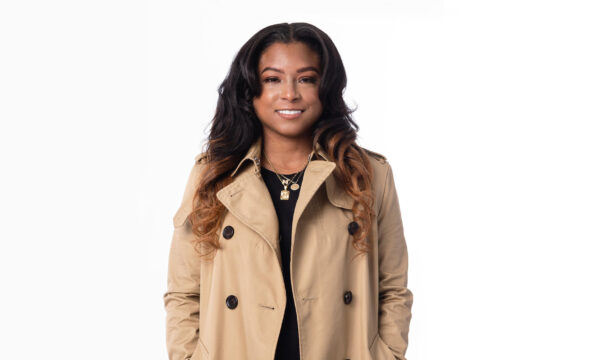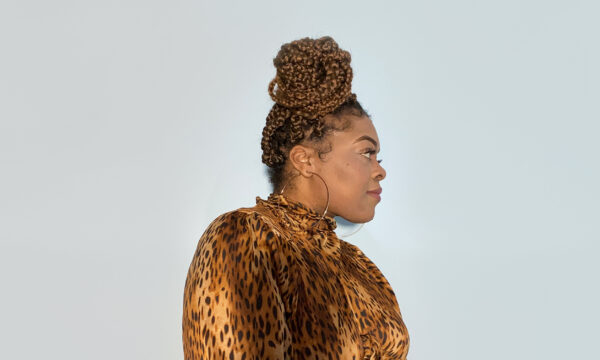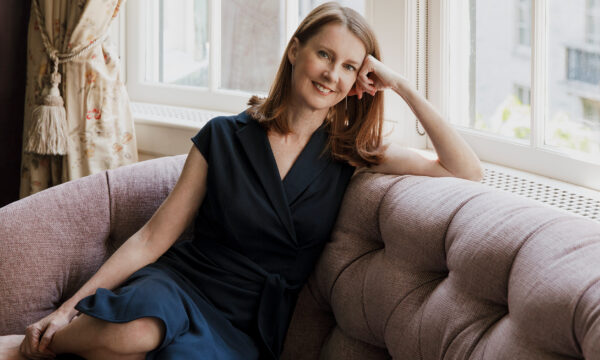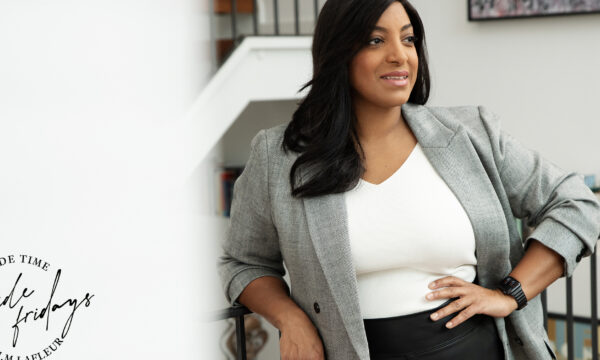
The Sierra shacket, Leslie T-shirt, and Sammataro jeans.
Want a More Meaningful Career? Try Starting with a Personal Vision Statement
Executive and leadership coach Kacey Cardin shares her advice for prioritizing purpose-driven work.
Last fall, M.M. partnered with Harris Poll to conduct a survey aimed at figuring out where professional women stood almost 19 months into the pandemic. And this result really stuck with us: Over 92% of women surveyed reported that the pandemic taught them that time is too precious to waste on things, people, and careers that do not serve them.
It’s not that this came as a huge surprise—“The Great Resignation” has been steadily brewing for years. “Collectively, we are giving ourselves permission to put ourselves first and pay attention to what our heart says, as much as our ego or our brain,” says Kacey Cardin, an executive and leadership coach, as well as a facilitator at Chief. “The pandemic made us all look at mortality and face some of those big conversations, and as a result, I’ve seen people lean more into authenticity, heart, and soul-level purpose.”
So how can we use this moment to find more meaning and satisfaction in our professional lives? According to Kacey, a purposeful career starts with a “personal vision statement.”
Kacey Cardin is hosting a week-long women’s retreat in Costa Rica from May 29-June 4, focused on transformation, relaxation, and rejuvenation. Learn more and sign up here, plus get $200 off if you sign up before April 15.

Kacey Cardin
Define Your Vision
“Try this visualization exercise,” she suggests. “If you could wave a magic wand, and every human could have an experience, emotion, or way of being—what experience would you choose? It should be something that you find really exciting and that makes you feel more alive. Some of my clients have created very specific vision statements, like, ‘I want every woman and girl in the world to have access to education by 2030.’ For other people, it’s something like, ‘I wish everyone could have the experience of family and community, and that no person would ever feel abandoned.’”
Some people might read Kacey’s advice and immediately know what their vision statement is. But for others, it will require a bit more introspection. Luckily, she has some useful tips for getting started. “Think of it in three circles: the ‘me’ (yourself), the ‘we’ (your family/social circle/community), and the ‘all’ (the world),” she says. “I like starting with the ‘all,’ because your ‘me’ and your ‘we’ are under that bigger umbrella. Try actually drawing those circles, and then fill them in with the best possible outcome you can imagine for yourself, the people around you, and the world. Ask yourself: What do I secretly long for that I think is IMPOSSIBLE? Filling in that blank is a really great place to start.”
Click here for a visual version of Kacey’s vision statement exercise.
“Another part of creating your vision statement is allowing yourself to ponder what matters to you when there is nothing to fix and nothing to prove. Often, people’s first attempt at a vision statement will be a reaction to something they don’t like. Instead, you should get in touch with what you do like and want more of in the world. What you resist persists, and often, if we’re trying to fix or prove something, we end up creating more of what we don’t want.”

The Porter jacket and Krista skirt.
Live Your Vision
Like most goals, your personal vision statement will be most effective if it’s specific and measurable. “Break it down and create some milestones that will let you know if you’re on the right track,” suggests Kacey. “Every single day, ask yourself, ‘Are my thoughts, words, and actions moving me closer to the vision I’m committed to? And if not, what do I need to shift? Who do I need to be?’ An example that I’m working on right now is a women’s retreat I’m leading in Costa Rica this summer. My vision is for all leaders to feel authentically expressed, joyful, safe, and celebrated—and the way I’m bringing that vision to life is by creating transformational retreats for women to experience self-love, a life fueled by desire, soul goals, and full self-expression. My specific, measurable milestones include having 8 women registered by April 8th and 16 women registered by May 18th. Every day, I am mindful that my thoughts, words, and actions are moving me closer to hitting those milestones.”
Actionable Takeaway
Ask yourself: What is your vision for the world? What are some measurable ways to bring it to life? And how will you know you’re on the right track (milestones/by whens)?
There’s a tendency to think of our careers as solitary pursuits, but according to Kacey, a solid support system is a key part of crafting and adhering to your vision statement. “You have to know who you’re going to call when the shit hits the fan,” she says. “You need people who know what you’re up to, know what your goal is, and believe in your goal—and will keep you going when you want to stop. One of my mentors recently reminded me, ‘Either the pain will push you or the vision will pull you.’ I’d much prefer to live a life guided by vision than pushed by pain.”
Kacey notes that specific and measurable goals are important, but it’s not enough to simply create them—you also have to visualize yourself achieving them. “Declarations are one of humanity’s most underutilized tools,” she says. “It’s not about slapping positive affirmations on things we don’t like. A declaration is a verbal commitment to the future we desire and a stated belief in our own innate creative power. I’ll often have clients write as if it’s the day that ‘the thing’ is happening—almost like a journal entry of how the day goes and how they feel—allowing them to step into the shoes of their future self. What always amazes me is how many of the things they write down actually end up happening exactly as they described it.”

The Hyo jacket, Elsa dress, and Beatriz earrings.
Set Healthy Boundaries
Clarifying your sense of purpose can also help you set better boundaries. “Once you have your North Star and know your priorities,” says Kacey, “you can identify areas where you’re being pulled off course and need to strengthen your boundaries. Many of us have some version of ‘I don’t deserve…,’ or ‘I don’t have the right to ask for…’ Identify what that story is for you, and then flip it around: ‘I have the right to rest,’ or ‘I have the right to take time for myself.’ Create some statements that align with the life that you want to be living, and then get clear on what’s negotiable and what’s non-negotiable.”
Click here for a visual guide to setting healthy boundaries.
Of course, healthy boundaries are a two-way street, and Kacey notes that it’s equally important to respect the boundaries of those around us. “It’s not always comfortable or easy, but the price of not honoring boundaries is that it chips away at our integrity, self-trust, and dignity,” she says. And part of honoring others’ boundaries is about seeing them not as a confrontation, but as an invitation to strengthen the relationship. Kacey shares an example from her own life: “Recently, a friend asked me to stop inviting them to a particular event—they didn’t want to go, and they were tired of me trying to convince them otherwise. My immediate internal response was to feel offended, angry, shameful, and then sad. But I took a moment to process my emotional reaction, then humbly thanked them for clarifying their boundary, and we went on with our conversation. This is a fairly innocuous example, but the more we practice responding to boundaries in low-stakes situations, the easier it gets to state our own and honor other people’s in high-stakes moments.”

The Lalita dress and Frida earrings.
Create an Environment Where Everyone Can Thrive
While creating your personal vision statement is a great starting point, employees can only find that sense of purpose if company leaders create an environment where everyone can thrive. “And as a leader, you need to be clear on what your employees want more of and what really matters to them,” says Kacey. “People show up for things to which they feel emotionally connected. Too many workplaces create a culture of ‘keep your head down and don’t rock the boat.’ That atmosphere kills creativity and innovation. If people don’t feel safe, they don’t take risks, and they don’t give you their best. It’s great feedback as a leader if you ask people what they need, and they say, ‘I don’t know.’ That tells you that you haven’t yet earned their trust or created a safe space for them to communicate their needs.”
“You may assume, ‘Oh, people want ping pong tables and open office spaces,’ only to discover (after spending a lot of money on an office revamp) that what people actually want is flexible hours and purpose-driven work. It’s vital to ask frequently whether people are getting what they need and how their needs have shifted. As a coach, I constantly ask people, ‘What do you need?’ And I am always shocked at the amount of people who say, ‘Nobody’s ever asked me that before.’”
Kacey says that well-being at work often boils down to one important question: “Are people allowed to be human? Do they feel safe making mistakes? Do they have sunlight and water and adequate breaks built into their days? This may sound silly, but it can even extend to things like whether the temperature is comfortable for people in the building. At the end of the day, we’re all human and basically want the same things: to be accepted, to belong, and to do work that matters. We want purpose.”










